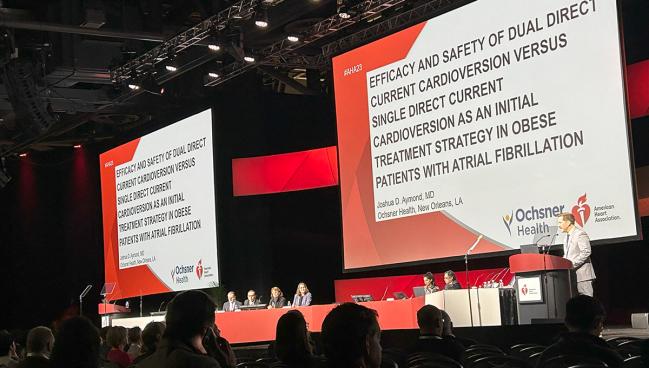Simultaneous Dual Cardioversion of AF Lessens Failure Rates in Obese Patients
Doubling the energy delivered was a safe and effective way to overcome challenges associated with increased BMI.

PHILADELPHIA, PA—For patients with obesity who are undergoing electrical cardioversion for atrial fibrillation (AF), delivering twice the energy with a simultaneous dual approach is a better option than a conventional approach involving a single set of pads, a randomized trial shows.
The dual approach, which delivered 400 J versus 200 J of energy, significantly reduced the rate of failure to restore sinus rhythm (14% vs 2%; P = 0.002), Joshua Aymond, MD (Ochsner Health, New Orleans, LA), reported here at the American Heart Association 2023 Scientific Sessions, adding that the strategy “is more effective than conventional single cardioversion without an increased risk of complications or discomfort.”
Obesity is associated with up to a 50% increase in the incidence of AF, and rates of both conditions are on the rise. This is a problem when it comes to cardioversion because obesity increases the likelihood that the procedure will fail to put a patient back into sinus rhythm, an issue thought to be related to an increase in resistance to the flow of the electrical current and possibly left atrial size, Aymond explained.
There is some evidence that the success of cardioversion in patients with obesity is improved with an increase in shock energy, and use of an initial high shock energy is recommended and discussed in current guidelines.
Use of dual direct current cardioversion—with two sets of defibrillator pads—appears to be a safe and effective way to increase the shock energy, but, until now, that strategy had only been studied in patients with cardioversion-refractory AF.
To study dual cardioversion as an initial strategy in a population known to be at risk for failing the intervention, Aymond and his colleagues enrolled 200 adults (mean age 65.5 years; 36.5% women) with AF and a body mass index (BMI) of 35 kg/m2 or higher who were scheduled to undergo nonemergent cardioversion at one of three Louisiana centers and were on adequate anticoagulation. Mean BMI was 41.2 kg/m2. Patients were generally well matched by clinical and echocardiographic characteristics, medication use, and medical history, although those in the single cardioversion group were older on average.
Patients were randomized 1:1 to simultaneous dual or single cardioversion. Two sets of defibrillator pads were placed on each patient. Both sets were used to deliver 400 J of total shock energy for patients in the dual group, and one set was used to deliver 200 J of energy for patients in the single group. If cardioversion failed in patients treated with the single approach initially, they were then treated with dual shocks. Up to three total attempts could be made to restore sinus rhythm in both groups.
The primary outcome was restoration of sinus rhythm immediately following cardioversion, and the higher likelihood of failure with the single approach remained in a fully adjusted multivariable analysis (OR 12.6; 95% CI 1.3-118.9).
Of the 14 patients who failed single cardioversion on the first attempt, 12 had sinus rhythm restored with a first try at dual cardioversion; the remaining two had successful cardioversion with a second attempt using the dual approach.
Of the two patients who failed an initial dual approach, one had sinus rhythm restored and the other failed again with an additional attempt. The patient who failed the second attempt was treated with amiodarone, brought back 2 weeks later, and then successfully cardioverted using the dual strategy.
Chest discomfort after the procedure was rated a median 0 out of 10 by patients in both groups, and there were no procedure-related adverse outcomes. There was no information on long-term outcomes, which Aymond cited as a limitation of the study.
Commenting for TCTMD, Jonathan Piccini, MD (Duke University, Durham, NC), one of the moderators of the late-breaking science session where Aymond presented the results, said the cardioversion of patients with obesity is common scenario.
“I thought the trial was great because it addresses a problem that almost every cardiologist, hospital, and cardioversion team is faced with,” Piccini said. A number of different approaches have been tried to improve the success of cardioversion in this setting—manually putting increased pressure on the defibrillator pads, performing dual cardioversion in a sequential fashion, using a very high energy initially, or the simultaneous dual approach evaluated in this trial, he said.
With these results, it might push more cardioversion teams to use the simultaneous dual strategy, which is not commonly employed today, Piccini predicted. The trial “showed that having a regimented approach to these patients results in the best outcomes, and I suspect a lot of people leaving the scientific sessions who saw the talk are probably going to make a change to their practice for patients with a BMI over 35.”
Noting that some defibrillators on the market can deliver 360 J of energy during cardioversion, Piccini said he wasn’t concerned about delivering 400 J at one time.
And Jose Joglar, MD (UT Southwestern Medical Center, Dallas, TX), who served as the discussant following Aymond’s presentation, seemed to agree. “Above all, I want to mention that high energies were safe” in the trial, he said.
The study, Joglar said, “helps fill an important knowledge gap on how to best deal with defibrillation in obesity, which . . . commonly is a risk factor for atrial fibrillation. So this study adds credibility to the use of cardioversion dual defibrillators in refractory patients.”
He added that use of currently available defibrillators delivering 360 J of shock energy, along with application of pressure to the pads, will likely be the ideal initial approach for patients with obesity.
“But for now, I think the use of more-liberal, high-energy outputs, especially if you only have 200 J defibrillators, maybe [with] an initial energy of 400 J, certainly [has] a place in the marketplace and in our general practice,” Joglar said.
Todd Neale is the Associate News Editor for TCTMD and a Senior Medical Journalist. He got his start in journalism at …
Read Full BioSources
Aymond JD. Efficacy and safety of dual direct current cardioversion versus single direct current cardioversion as an initial treatment strategy in obese patients with atrial fibrillation. Presented at: AHA 2023. November 12, 2023. Philadelphia, PA.
Disclosures
- Aymond and Joglar report no relevant conflicts of interest.





Comments